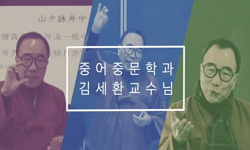The word Deuknan(得難) which was a word indicating the social status of particular figures, and the annotations for that word (the Deuknan-jo section/得難條) which were created by the editor of the <Seongjusa Nanghae Hwasang Tabbi (also known ...
http://chineseinput.net/에서 pinyin(병음)방식으로 중국어를 변환할 수 있습니다.
변환된 중국어를 복사하여 사용하시면 됩니다.
- 中文 을 입력하시려면 zhongwen을 입력하시고 space를누르시면됩니다.
- 北京 을 입력하시려면 beijing을 입력하시고 space를 누르시면 됩니다.

聖住寺 無染碑의 '得難'條에 대한 考察 = A Study on the word Deuknan(得難) of Seongjusa Nanghae Hwasang Tabbi(聖住寺郞慧和尙塔碑)
한글로보기부가정보
다국어 초록 (Multilingual Abstract)
The word Deuknan(得難) which was a word indicating the social status of particular figures, and the annotations for that word (the Deuknan-jo section/得難條) which were created by the editor of the <Seongjusa Nanghae Hwasang Tabbi (also known as the Muyeom-bi tablet)>(聖住寺郞慧和尙塔碑/無染碑), have all been considered extremely invaluable for the researchers who were trying to figure out the inner structure and dynamics of the Golpum-jae(骨品制/ Bone-rank system) classification. But the researchers' interpretations of the 49 letters of this Deuknan-jo section have very much varied over the years, and therefore usually the understandings of a particular word or sentence have been intoterably different from one another.
The Deuknan-jo section was created by Choi Chi Weon(崔致遠), to help the Chinese people understand the term Deuknan, which was being used in the area of classification. So this researcher decided to re-examine the text itself while also keeping in mind the original intent of the editor. In order to do that this researcher tried to stay away from any previously announced interpretations to avoid falling victim to any unnecessary presuppositions, and also tried to interpret the text matter not with the Korean ways of interpreting Chinese letters(which has been developed since the later days of the Chosun dynasty) but with the grammatical system which was supposedly used by the Chinese intellects during the latter half of the 9th century. The following are the results of this new attempt.
The five ranks (五品) , to which the Shilla officials of the ending days of the 9th century were subjected, were the Song-Ih-Jingol figures (otherwise known as the Songgol & Jingol members=聖骨ㆍ眞骨=the Hallowed-bone & True-bone members), the Deuknan figures, and the 6th/Yuk, 5th/Oh and 4th/Sa Dupum figures (Head-rank six, five and four). The 'Song-Ih-Jingol' title was not a merged title for both the Songgol and Jingol figures as believed by many researchers, but rather a title for a group of people who were all hallow and truly honorable in their nature and social status. This means that even though the House of King Gyeongmun -wang tried to enforce the Hallowed-bone sentimentality in order to outrank and outclass the other ordinary True - bone members during the later periods of the 9th century, it was not able to establish the Hallowed-bone concept as an independent definition of a class. The Deuknan class was demoted from the rank of a True-bone class, but it was still a noble class. Because the only source from the Shilla dynasty where the mention of a Deuknan figure can be confirmed is the Muyeom-bi(無染碑) tablet epitaph, some scholars doubt the very existence of the Deuknan figure itself. But researches conducted by this researcher suggest that, unlike the existing theories, the Deuknan figure did appear during the time period in which Muyeom(無染/800-888) father Beomcheong(範淸) lived, and it was established as an independently stratified class, positioned between the True-bone members and the Yukdu-pum members, during the reign of Queen Jinseong-yeowang(眞聖女王/887 -897), when the tablet epitaph was created. These particular figures were called Deuknan figures because they were able to use the noble names in a time when not only the high class nobles but also the middle and lower class ones were also becoming able to use last names in addressing themselves, and therefore making other people's use of those names increasingly difficult during the 9th century. These Deuknan figures must have been granted privileges which were usually only granted to the nobles. The types and nature of the privileges, which would have usually meant exemption from national services, are all examined here and also compared to the other examples of the Chinese dynasties since the days of the North & South period and till the Tang dynasty period.
목차 (Table of Contents)
- Ⅰ. 머리말
- Ⅱ. 텍스트 검토
- Ⅲ. 得難條 풀이
- Ⅳ. 得難과 貴姓
- Ⅴ. 맺음말
- Ⅰ. 머리말
- Ⅱ. 텍스트 검토
- Ⅲ. 得難條 풀이
- Ⅳ. 得難과 貴姓
- Ⅴ. 맺음말
동일학술지(권/호) 다른 논문
-
- 한국고대사학회
- 南武熙
- 2002
- KCI등재후보
-
- 한국고대사학회
- 李道學
- 2002
- KCI등재후보
-
- 한국고대사학회
- 朴仲煥
- 2002
- KCI등재후보
-
- 한국고대사학회
- 서영수
- 2002
- KCI등재후보
분석정보
인용정보 인용지수 설명보기
학술지 이력
| 연월일 | 이력구분 | 이력상세 | 등재구분 |
|---|---|---|---|
| 2026 | 평가예정 | 재인증평가 신청대상 (재인증) | |
| 2020-01-01 | 평가 | 등재학술지 유지 (재인증) |  |
| 2017-01-01 | 평가 | 등재학술지 유지 (계속평가) |  |
| 2013-01-01 | 평가 | 등재학술지 유지 (등재유지) |  |
| 2010-01-01 | 평가 | 등재학술지 유지 (등재유지) |  |
| 2008-07-07 | 학회명변경 | 영문명 : The Korean Ancient Historical Association -> The Society for Ancient Korean History |  |
| 2008-01-01 | 평가 | 등재학술지 유지 (등재유지) |  |
| 2005-01-01 | 평가 | 등재학술지 선정 (등재후보2차) |  |
| 2004-01-01 | 평가 | 등재후보 1차 PASS (등재후보1차) |  |
| 2002-01-01 | 평가 | 등재후보학술지 선정 (신규평가) |  |
학술지 인용정보
| 기준연도 | WOS-KCI 통합IF(2년) | KCIF(2년) | KCIF(3년) |
|---|---|---|---|
| 2016 | 1.69 | 1.69 | 1.84 |
| KCIF(4년) | KCIF(5년) | 중심성지수(3년) | 즉시성지수 |
| 1.64 | 1.57 | 3.463 | 0.17 |




 DBpia
DBpia



